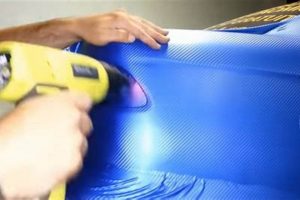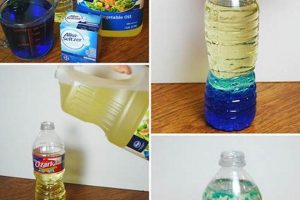The process of adjusting vehicle wheel angles by oneself, rather than relying on professional services, can be referred to as a “do-it-yourself” approach to ensuring proper wheel positioning. This involves using tools and techniques to modify the angles of the wheels to meet manufacturer specifications or desired handling characteristics. For example, a vehicle owner might employ levels, measuring tapes, and specialized tools to adjust camber, caster, and toe angles in their garage.
Performing such adjustments at home can offer potential cost savings and increased control over the vehicle’s handling. Historically, individuals with mechanical aptitude and access to resources have undertaken this task. Benefits can include improved tire wear, enhanced fuel efficiency, and more precise steering. However, the accuracy and safety of this approach depend heavily on the user’s knowledge, skills, and the quality of the tools employed.
The subsequent sections will delve into the tools and methods required for effective wheel adjustments, discuss the critical safety considerations, and outline the potential risks involved in pursuing this independent approach. Furthermore, the process of accurately measuring wheel angles and interpreting specifications will be addressed, providing a complete overview of the requirements for successful execution.
DIY Alignment
Effective “diy alignment” requires precision, patience, and a thorough understanding of vehicle geometry. The following tips will assist in achieving accurate and safe wheel adjustments.
Tip 1: Consult the Vehicle’s Service Manual. Adherence to manufacturer specifications for camber, caster, and toe is crucial. The service manual provides these critical values.
Tip 2: Invest in Quality Measuring Tools. Accurate measurement is paramount. Levels, digital angle finders, and specialized alignment gauges are essential for obtaining reliable readings.
Tip 3: Ensure a Level Work Surface. Performing adjustments on an uneven surface will introduce errors into the alignment process. A level garage floor or designated alignment rack is required.
Tip 4: Loosen Fasteners Before Adjustment. Attempting to force adjustments without loosening relevant bolts and nuts can damage suspension components. Apply penetrating oil if necessary.
Tip 5: Make Small, Incremental Adjustments. Avoid making large, abrupt changes. Small adjustments are easier to correct and minimize the risk of over-correction.
Tip 6: Double-Check All Measurements. After each adjustment, re-measure all angles to ensure they are within the specified tolerance range. Consistency is key to accurate alignment.
Tip 7: Torque Fasteners to Specification. Following adjustments, tighten all fasteners to the torque values outlined in the service manual. This prevents loosening and maintains alignment.
Tip 8: Test Drive and Re-Evaluate. After completing the alignment, conduct a test drive to assess handling characteristics. Re-check measurements and make further adjustments as needed.
Adhering to these tips during “diy alignment” can result in improved tire wear, enhanced handling, and increased fuel efficiency. However, safety should always be the primary consideration. If unsure about any aspect of the process, seeking professional assistance is recommended.
The subsequent sections will cover troubleshooting common alignment issues and provide guidance on recognizing when professional intervention is necessary.
1. Accurate Measurement
In the context of “diy alignment,” accurate measurement serves as the cornerstone of success. It represents the fundamental difference between a potentially beneficial adjustment and one that could degrade vehicle handling, accelerate tire wear, or even compromise safety. Errors in measurement propagate through the entire alignment process, rendering subsequent adjustments ineffective or, worse, detrimental. For example, if the camber angle is incorrectly measured, any attempt to correct it will likely result in an angle that deviates even further from the manufacturer’s specification, leading to uneven tire wear and impaired steering response.
The tools used for measurement directly impact the accuracy of the “diy alignment” process. A simple bubble level, while inexpensive, may not provide the precision required for modern vehicles. Digital angle finders and laser alignment tools, though more expensive, offer significantly improved accuracy and repeatability. Furthermore, proper calibration of these tools is essential. An uncalibrated tool, regardless of its initial quality, will produce inaccurate measurements, negating its advantages. The service manual will state proper values, and deviations during measurement will require the vehicle owner to make adjustments to bring the vehicle back into compliance. For instance, a discrepancy of even 0.1 degrees in toe angle can result in noticeable tire wear over time. This highlights the critical importance of both the tools used and the meticulousness of the measurement process.
In summary, accurate measurement is not merely a preliminary step in “diy alignment”; it is the foundation upon which all subsequent adjustments are based. Imprecise measurements undermine the entire process, potentially leading to negative outcomes. The selection of appropriate, calibrated tools and the adherence to meticulous measurement techniques are crucial for achieving the desired results and ensuring both the safety and longevity of the vehicle. This understanding highlights the need for careful consideration before undertaking “diy alignment” and underscores the potential benefits of professional assistance when precise measurements are paramount.
2. Tool Calibration
Tool calibration forms an indispensable element within the scope of “diy alignment.” It represents the systematic process of ensuring measurement tools provide accurate and reliable readings, critical for achieving precise adjustments to vehicle wheel angles. Without proper calibration, even the most sophisticated alignment equipment can yield erroneous data, leading to compromised handling and accelerated tire wear.
- Accuracy Assurance
Calibration verifies that alignment tools conform to established standards. This is particularly relevant when measuring minute angular deviations in camber, caster, and toe. Inaccurate readings, even by a fraction of a degree, can cumulatively result in significant alignment errors. Regular calibration ensures adherence to specified tolerances, crucial for optimizing vehicle performance and safety in “diy alignment”.
- Repeatability and Consistency
Calibration enhances the repeatability and consistency of alignment measurements. A properly calibrated tool will produce similar readings under identical conditions, mitigating the influence of envi
ronmental factors or user variability. This consistency is paramount when performing iterative adjustments during “diy alignment,” ensuring that each modification is based on reliable data. - Longevity and Tool Maintenance
Routine calibration identifies potential wear and tear on alignment tools. Detecting and addressing issues early prevents the accumulation of errors and extends the lifespan of the equipment. For instance, a digital level with a degraded sensor can produce progressively inaccurate readings, leading to substantial alignment problems if left unchecked. Calibrating tools helps to identify issues and maintain equipment for prolonged use in “diy alignment”.
- Mitigation of Systematic Errors
Calibration minimizes the impact of systematic errors, which are consistent biases in measurement. These errors can arise from manufacturing imperfections or environmental influences. Calibration procedures account for and compensate for these systematic biases, ensuring that alignment adjustments are based on corrected data. Such error mitigation is critical in achieving accurate and reliable results when performing “diy alignment.”
The synergistic effect of accuracy assurance, repeatability, tool maintenance, and error mitigation underscores the fundamental importance of tool calibration in “diy alignment.” Its absence can lead to unpredictable results, rendering adjustments ineffective and potentially compromising vehicle safety and performance. As such, prioritizing tool calibration is essential for anyone undertaking wheel alignment adjustments independently.
3. Service Manual
The service manual serves as the definitive resource for undertaking “diy alignment” procedures. It provides the manufacturer’s specified alignment parameters, including camber, caster, and toe angles, tailored to the vehicle’s specific make, model, and year. These specifications represent the optimal alignment settings for achieving balanced handling, minimizing tire wear, and maximizing fuel efficiency. Deviating from these specifications, even within seemingly minor tolerances, can have detrimental effects on vehicle performance and safety. Attempting “diy alignment” without consulting the service manual is akin to performing surgery without understanding human anatomy; it carries a high risk of unintended and adverse consequences. For example, adjusting the toe angle outside the specified range can lead to rapid and uneven tire wear, requiring premature tire replacement. The service manual provides a crucial understanding of cause and effect.
The importance of the service manual extends beyond simply providing alignment specifications. It also details the correct procedures for adjusting various suspension components. This includes the proper sequence for loosening and tightening fasteners, the recommended torque values, and any specialized tools required for the task. Furthermore, the service manual often includes diagrams and illustrations that clarify the location of adjustment points and the orientation of various suspension parts. Neglecting these procedural details can result in damaged components, compromised safety, and a failed “diy alignment” attempt. As an example, improperly torquing a control arm bolt can lead to premature wear of the bushing or even failure of the bolt itself, requiring costly repairs. The service manual acts as a safeguard against such errors, transforming potential damage into successful tasks.
In conclusion, the service manual is an indispensable component of “diy alignment.” It provides the essential specifications, procedures, and safety information necessary for achieving accurate and safe wheel alignment adjustments. Attempting “diy alignment” without consulting and adhering to the service manual significantly increases the risk of errors, damage, and compromised vehicle performance. While “diy alignment” can offer cost savings and increased control, it should only be undertaken with a thorough understanding of the vehicle’s alignment requirements, as outlined in the service manual. The absence of this crucial resource transforms “diy alignment” from a potentially beneficial endeavor into a hazardous undertaking.
4. Surface Level
The requirement for a level surface constitutes a foundational element in the practice of “diy alignment.” The accuracy of any wheel alignment adjustment hinges directly on the stability and evenness of the underlying work area. A non-level surface introduces extraneous angles and artificial inclines, distorting measurements and rendering any subsequent adjustments inherently flawed. For instance, if a vehicle rests on a surface with a subtle slope, gravity will act unevenly on the suspension components, altering the apparent camber and caster angles. This can lead to incorrect adjustments that exacerbate handling problems rather than resolving them. The consequence is misalignment and, at the extreme, safety risk.
The importance of a level surface extends beyond simply ensuring accurate angle measurements. It also affects the predictability and repeatability of adjustments. When a vehicle is resting on an uneven surface, the suspension components may be under strain or compression in unpredictable ways. This can make it difficult to achieve consistent results when loosening and tightening fasteners, or when making small incremental adjustments to camber, caster, or toe. Consider a scenario where a vehicle’s front end is slightly higher than the rear. Adjusting the toe on the front wheels may inadvertently affect the rear wheel alignment, leading to a cascade of unintended consequences. In practice, the user finds additional steps are needed to remediate the adverse effect of an unlevel surface.
In conclusion, achieving a truly level surface is not merely a desirable condition, but a prerequisite for undertaking effective “diy alignment.” Failure to address this fundamental requirement compromises the accuracy of measurements, introduces unpredictable variations, and ultimately undermines the entire alignment process. While achieving perfect levelness may require specialized equipment or techniques, prioritizing this aspect significantly increases the likelihood of a successful and safe “diy alignment” outcome. The presence of a truly level work area translates to a solid step toward precision and improved vehicle handling.
5. Incremental Adjustments
The principle of incremental adjustments is paramount to the successful execution of “diy alignment.” It acknowledges the inherent complexities of vehicle suspension systems and the potential for unforeseen consequences when altering alignment parameters. This approach advocates for small, deliberate changes, followed by careful assessment, as opposed to large, sweeping modifications.
- Minimizing Overcorrection
Large adjustments increase the risk of overcorrection, wherein the alignment parameters are moved beyond the desired range. Overcorrection necessitates additional adjustments in the opposite direction, potentially leading to a cycle of errors. Incremental changes allow for a more controlled approach, reducing the likelihood of exceeding the target values. For example, adjusting toe-in by only a fraction of a
degree at a time, followed by re-measurement, can prevent excessive inward toe that would cause rapid tire wear. - Facilitating Error Detection
Small adjustments make it easier to identify and diagnose any unintended consequences of the changes made. Large adjustments can mask subtle effects, making it difficult to pinpoint the source of any handling issues that arise. By making small, incremental changes, the impact of each adjustment can be more readily assessed. If, for example, a slight change to caster results in unwanted steering pull, the minimal nature of the adjustment allows for easier identification of the cause and quicker reversion to the previous setting.
- Accommodating Suspension Interdependencies
Vehicle suspension systems exhibit interdependencies, meaning that a change to one alignment parameter can influence others. Large adjustments can create significant imbalances, requiring extensive re-adjustments. Incremental adjustments provide an opportunity to observe and compensate for these interdependencies in a more controlled manner. For example, a minor adjustment to camber may slightly affect toe, which can then be corrected incrementally, maintaining overall alignment integrity.
- Promoting Iterative Refinement
Incremental adjustments facilitate an iterative refinement process, where each adjustment is informed by the results of the previous one. This allows for a more precise and optimized alignment outcome. Instead of aiming for a single, definitive adjustment, the process becomes a series of small, calculated steps, each bringing the alignment closer to the desired specifications. The driver can test handling, adjust, and retest over a set period of time, and by performing “diy alignment”, adjust to preference for their particular driving style.
The adoption of incremental adjustments transforms “diy alignment” from a potentially haphazard undertaking into a more controlled and methodical process. It recognizes the complexities of vehicle suspension systems and prioritizes precision and careful observation. By embracing this approach, individuals undertaking “diy alignment” increase their chances of achieving a successful and safe outcome, avoiding the pitfalls of overcorrection and unintended consequences. This careful approach is critical to DIY activities.
6. Torque Specifications
Adherence to torque specifications represents a non-negotiable aspect of safe and effective “diy alignment.” Properly torquing fasteners to manufacturer-specified values ensures secure component attachment and prevents both premature wear and catastrophic failure. Deviation from these specifications, whether through under- or over-tightening, carries significant risks that undermine the entire alignment process.
- Ensuring Structural Integrity
Correct torque application guarantees that suspension components are securely fastened to the vehicle’s chassis. Under-torquing can lead to loosening of fasteners over time, resulting in component slippage, alignment drift, and potentially dangerous instability. Conversely, over-torquing can stretch or even break fasteners, weakening the joint and predisposing it to failure under stress. Proper torque ensures the joint is preloaded correctly and can withstand the intended load, with the components designed to work together. The fasteners are, in essence, clamps.
- Maintaining Alignment Parameters
Suspension components are designed to operate within precise tolerances. Incorrect torque application can distort these components, altering the intended alignment parameters. For example, over-torquing a control arm bushing can compress it excessively, changing the suspension geometry and affecting camber, caster, or toe angles. This unintended alteration negates the carefully made alignment adjustments, defeating the purpose of “diy alignment” itself.
- Preventing Component Damage
Many suspension components, particularly those made of aluminum or composite materials, are susceptible to damage from over-torquing. Stripped threads, cracked housings, and deformed brackets are all potential consequences of exceeding torque specifications. Such damage can render components unusable, requiring costly repairs and delaying the “diy alignment” process. Component material is an important element to consider when reviewing torque specifications.
- Ensuring Safe Operation
Ultimately, adherence to torque specifications is a matter of safety. Properly secured suspension components are essential for maintaining vehicle control and preventing accidents. Loose or damaged components can lead to unpredictable handling, steering instability, and even complete suspension failure. Strict adherence to torque specifications is therefore crucial for ensuring the safe operation of the vehicle after “diy alignment.”
The ramifications of neglecting torque specifications extend far beyond simple inconvenience. They encompass structural integrity, alignment accuracy, component durability, and, most importantly, vehicle safety. Therefore, “diy alignment” should never be undertaken without access to and diligent adherence to the manufacturer’s torque specifications for all relevant suspension fasteners. Torque wrenches are essential tools for home alignment enthusiasts.
7. Test Drive
The test drive represents a critical validation phase in the “diy alignment” process, bridging the gap between theoretical adjustments and real-world performance. It serves as a practical assessment of the effectiveness of the alignment modifications and provides essential feedback for fine-tuning vehicle handling characteristics.
- Objective Handling Assessment
The test drive allows for an objective evaluation of steering response, stability, and overall handling. This involves driving the vehicle under various conditions, including straight-line cruising, cornering, and braking. Any deviations from expected behavior, such as steering pull, excessive body roll, or instability under braking, indicate potential alignment issues requiring further attention. During the test drive, the user is also attempting to determine if the vehicle handling meets their own expectations and driving style.
- Tire Wear Monitoring
While not immediately apparent, the test drive provides an opportunity to indirectly assess potential tire wear patterns. By observing the vehicle’s behavior and feeling for any unusual vibrations or noises, one can infer whether the tires are being subjected to excessive stress or uneven wear. A prolonged test drive may reveal tire squeal during turns, suggestive of improper camber or toe settings contributing to premature tire wear, though squeal is more quickly noticeable.
- Steering Wheel Centering Verification
The test drive facilitates verification of proper steering wheel centering. Ideally, the steering wheel should be centered when the vehicle is traveling straight. If the steering wheel is off-center after “diy alignment,” it indicates that the toe angles are not properly balanced, requiring further adjustment. Precise steering wheel centering is essential for maintaining directional stability and preventing driver fatigue.
- Long-Term Performance Evaluation
Beyond immediate h
andling characteristics, the test drive provides insight into the long-term performance implications of the “diy alignment.” By monitoring tire wear patterns, fuel efficiency, and overall vehicle behavior over an extended period, the effectiveness of the alignment can be assessed. This feedback loop allows for continuous improvement and refinement of future “diy alignment” efforts. Tire wear is generally measured in thousandths of an inch.
The test drive, therefore, is not merely a post-adjustment formality but an integral component of the “diy alignment” process. It provides invaluable real-world feedback that informs subsequent adjustments, ultimately contributing to improved vehicle handling, tire longevity, and overall driving safety. While sophisticated diagnostic equipment can provide precise measurements, the test drive remains a crucial tool for validating the subjective feel and performance of the alignment adjustments.
Frequently Asked Questions
This section addresses common inquiries regarding the practice of DIY alignment, providing factual information to assist individuals in making informed decisions.
Question 1: Is DIY alignment a suitable task for all vehicle owners?
DIY alignment is not universally recommended. It demands a comprehensive understanding of vehicle suspension systems, precise measurement skills, and access to specialized tools. Individuals lacking these prerequisites should seek professional assistance to ensure accuracy and safety.
Question 2: What are the primary risks associated with DIY alignment?
Inaccurate adjustments can lead to uneven tire wear, compromised handling stability, and potential damage to suspension components. Over-tightening fasteners can cause breakage, while under-tightening can result in component loosening and failure. Safety is paramount; incorrect alignment can lead to accidents.
Question 3: What tools are essential for performing DIY alignment?
Essential tools include a reliable angle finder (digital levels are recommended), measuring tapes, wrenches, a torque wrench, jack stands, and wheel chocks. Access to a vehicle service manual is also critical for obtaining correct specifications.
Question 4: How important is a level surface when conducting DIY alignment?
A level surface is absolutely crucial. An uneven surface introduces errors into the measurement process, leading to incorrect adjustments. Compensating for an unlevel surface requires precise calculation and adds significant complexity.
Question 5: What are the key alignment parameters to consider during DIY alignment?
The primary parameters are camber, caster, and toe. Camber refers to the inward or outward tilt of the wheel, caster affects steering stability, and toe refers to the inward or outward angle of the wheels relative to each other. Each parameter must be adjusted within the manufacturer’s specified range.
Question 6: When should professional alignment services be considered instead of DIY alignment?
Professional alignment is advisable when dealing with complex suspension systems, experiencing persistent handling issues, or lacking the necessary tools or expertise. A professional alignment ensures accurate and lasting results, minimizing the risk of errors and potential damage.
DIY alignment offers potential cost savings but necessitates careful planning, precise execution, and a thorough understanding of vehicle mechanics. Prioritizing safety and accuracy is crucial for achieving a satisfactory outcome.
The following section will provide a detailed walkthrough of a typical DIY alignment procedure.
Conclusion
The preceding examination of “diy alignment” has detailed the multifaceted nature of this undertaking. Critical aspects, ranging from accurate measurement and tool calibration to adherence to torque specifications and the vital role of a level work surface, have been addressed. This exploration highlights that successful “diy alignment” transcends mere cost savings; it demands precision, expertise, and a rigorous commitment to safety protocols.
The decision to pursue “diy alignment” should not be taken lightly. While the potential for cost reduction and enhanced vehicle performance exists, the risks associated with improper execution are significant. Therefore, individuals considering this task must meticulously assess their capabilities, resources, and understanding of vehicle mechanics. Ultimately, a balanced evaluation of the potential benefits against the inherent risks will dictate whether “diy alignment” is a prudent course of action or if professional intervention is the more responsible approach.







